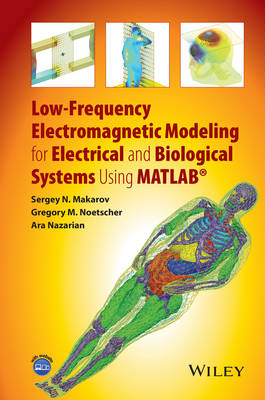
Low-Frequency Electromagnetic Modeling for Electrical and Biological Systems Using MATLAB
John Wiley & Sons Inc (Verlag)
978-1-119-05256-2 (ISBN)
Provides a detailed and systematic description of the Method of Moments (Boundary Element Method) for electromagnetic modeling at low frequencies and includes hands-on, application-based MATLAB® modules with user-friendly and intuitive GUI and a highly visualized interactive output.
Includes a full-body computational human phantom with over 120 triangular surface meshes extracted from the Visible Human Project® Female dataset of the National library of Medicine and fully compatible with MATLAB® and major commercial FEM/BEM electromagnetic software simulators.
This book covers the basic concepts of computational low-frequency electromagnetics in an application-based format and hones the knowledge of these concepts with hands-on MATLAB® modules. The book is divided into five parts. Part 1 discusses low-frequency electromagnetics, basic theory of triangular surface mesh generation, and computational human phantoms. Part 2 covers electrostatics of conductors and dielectrics, and direct current flow. Linear magnetostatics is analyzed in Part 3. Part 4 examines theory and applications of eddy currents. Finally, Part 5 evaluates nonlinear electrostatics. Application examples included in this book cover all major subjects of low-frequency electromagnetic theory. In addition, this book includes complete or summarized analytical solutions to a large number of quasi-static electromagnetic problems. Each Chapter concludes with a summary of the corresponding MATLAB® modules.
Combines fundamental electromagnetic theory and application-oriented computation algorithms in the form of stand alone MATLAB® modules
Makes use of the three-dimensional Method of Moments (MoM) for static and quasistatic electromagnetic problems
Contains a detailed full-body computational human phantom from the Visible Human Project® Female, embedded implant models, and a collection of homogeneous human shells
Low-Frequency Electromagnetic Modeling for Electrical and Biological Systems Using MATLAB® is a resource for electrical and biomedical engineering students and practicing researchers, engineers, and medical doctors working on low-frequency modeling and bioelectromagnetic applications.
Sergey N. Makarov is a Professor in the Department of Electrical and Computer Engineering at Worcester Polytechnic Institute (WPI). Gregory M. Noetscher is a Senior Research Electrical Engineer at the U.S. Army Natick Soldier Research, Development and Engineering Center (NSRDEC) in Natick, MA. Ara Nazarian is an Assistant Professor of Orthopaedic Surgery, Harvard Medical School, Center for Advanced Orthopaedic Studies, Beth Israel Deaconess Medical Center (BIDMC).
Preface xi
Acknowledgments xv
About The Companion Website xvii
Part I Low-Frequency Electromagnetics.Computational Meshes.Computational Phantoms 1
1 Classification of Low-Frequency Electromagnetic Problems. Poisson and Laplace Equations in Integral Form 3
2 Triangular Surface Mesh Generation and Mesh Operations 35
3 Triangular Surface Human Body Meshes for Computational Purposes 89
Part II Electrostatics of Conductors And Dielectrics. Direct Current Flow 131
5 Theory and Computation of Capacitance. Conducting Objects in External Electric Field 169
6 Electrostatics of Dielectrics and Conductors 215
7 Transmission Lines: Two-Dimensional Version of the Method of Moments 257
8 Steady-State Current Flow 289
Part III Linear Magnetostatics 347
9 Linear Magnetostatics: Surface Charge Method 349
10 Inductance. Coupled Inductors. Modeling of a Magnetic Yoke 371
Part IV Theory And Applications of Eddy Currents 423
11 Fundamentals of Eddy Currents 425
12 Computation of Eddy Currents via the Surface Charge Method 473
Part V Nonlinear Electrostatics 507
13 Electrostatic Model of a pn-Junction: Governing Equations and Boundary Conditions 509
14 Numerical Simulation of pn-Junction and Related Problems: Gummel’s Iterative Solution 547
Index 591
| Verlagsort | New York |
|---|---|
| Sprache | englisch |
| Maße | 158 x 236 mm |
| Gewicht | 975 g |
| Themenwelt | Naturwissenschaften ► Physik / Astronomie ► Elektrodynamik |
| Technik ► Elektrotechnik / Energietechnik | |
| ISBN-10 | 1-119-05256-4 / 1119052564 |
| ISBN-13 | 978-1-119-05256-2 / 9781119052562 |
| Zustand | Neuware |
| Haben Sie eine Frage zum Produkt? |
aus dem Bereich


